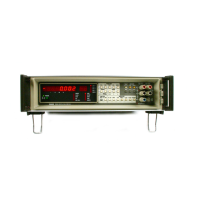8505A
completes the operation. The
multimeter
adopts
both the
mode specified with the
terminator
and the
value
previously displayed. If keystroked
numerics
are being
stored, the multimeter displays
the
digits as
they are
entered from the front panel.
Once all
numbers
for
a
particular
mode
are
entered, the
appropriate
terminator
button is
pushed. For either
method, the
display now
resumes the measurement
reading
function or,
if HI
or
LO were specified
as the terminator,
begins reading
HI,
LO, or PASS.
2-37.
The RECALL button commands
a display
of a
stored factor or value. The procedure
requires
the
following two steps when recalling
the offset value,
the
scaling factor, the filter mode, the
sample setting,
or the
zero value:
1. Push the
RECALL button (display responds
with T).
2.
Push the
appropriate terminator button
(OFFSET,
SCALING,
FILTER,
SAMPLE
or
ZERO).
The respective value
is
displayed
as
long
as
the terminator button is held depressed. Once the
terminator button is
released, the
multimeter
resumes
operation; no
mode or value
is changed.
2-38. The following three
push button steps are
required
to recall
a
limit or peak value.
!.
Push
RECALL
(display responds
with
“?”).
2. Then specify
whether
upper or
lower
limit
or
peak is desired
by pushing
HI
or LO
(display
responds
with “YES?”).
3. Finally, push the
appropriate
terminator
button (LIMITS
or PEAK).
2-39.
Front Panel Push
Buttons
2-40.
The multimeter
employs 25
color-coded
push
buttons on the
front panel.
Most of the
push
buttons
control more
than one function.
For
example,
many
mode control
push buttons also
serve
as numeric
entry
push buttons when used
during
a store operation.
The
number of keystrokes
required
for any
operation
is kept
to
a minimum. Refer to Figure
2-2
for
a description
of
each push button
and, where
applicable,
examples
of
typical programming
operations.
2-41.
Operation of the multimeter
is
straightforward.
Preset measurement
configurations
are
made
at power-
up, reset, or
function selection.
Programmed
values are
retained whenever
the range
or function
is changed.
Desired mode changes
are made
independently
following
a
programming
hierarchy
of:
1. Measurement Parameters
2.
Mathematic
Operations
3. Special Operations
The
FUNCTION push buttons allow
selection of
the analog measurement
function. Available functions
include: dc
volts (V
DC),
ac volts (V AC), dc current
(A DC), ac current
(A AC), and resistance
(OHMS
—
two wire or
four wire).
V DC
V AC
A DC
A
AC
Push V
DC for dc voltage
measurements with
6
'/
2-digit resolution
(V DC annunciator lights).
This
function is
standard for the
multimeter (no
optional module required). Five
ranges are
available:
1000V, 100V, 10V, IV, and 100
mV.
Push V AC for
ac
voltage
measurements
with 5Y
2
-digit
resolution (V AC annunciator
lights). This
function can
be used
with
either the
-01
Averaging Converter
or the -09A RMS
Converter. Four
ranges are
available:
1000V, 100V, 10V, and IV.
Push A DC for
dc
current
measurements
with 5V2 -digit resolution
(A DC annunciator
lights). This
function
can be used with
the -03 Current Shunts
module installed.
Five ranges are available:
1A,
100 mA, 10
mA, 1 mA, and
100 /jA.
Push A AC for
ac
current
measurements
with S'/^-digit resolution
(A AC annunciator lights).
This
function can be used when
the
-03
Current Shunts
module
and either the
-01
Averaging
Converter
or the
-09A RMS Converter
is installed. Available
ranges are
identical to those in
the
A
DC
function.
Figure
2-2.
Front
Panel Push Buttons
2-8

